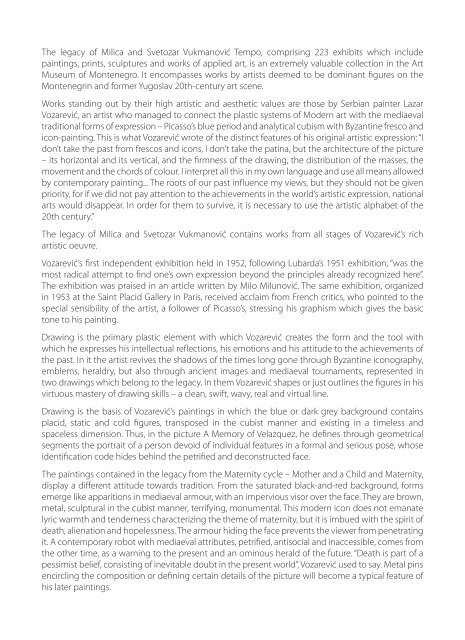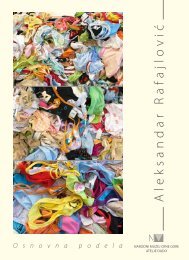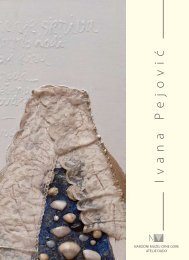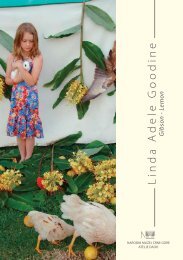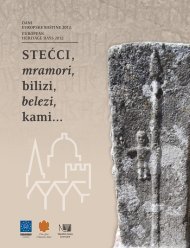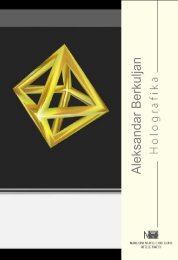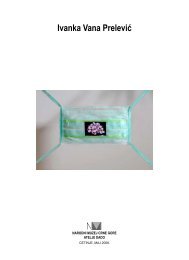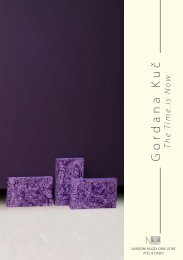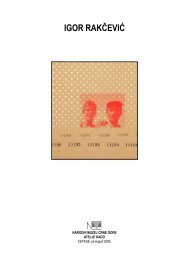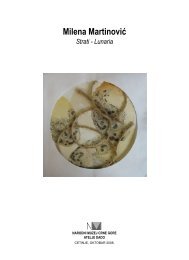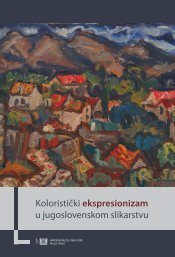Lazar Vozarevic katalog - GALERIJA ATELJE DADO
Lazar Vozarevic katalog - GALERIJA ATELJE DADO
Lazar Vozarevic katalog - GALERIJA ATELJE DADO
Create successful ePaper yourself
Turn your PDF publications into a flip-book with our unique Google optimized e-Paper software.
The legacy of Milica and Svetozar Vukmanović Tempo, comprising 223 exhibits which include<br />
paintings, prints, sculptures and works of applied art, is an extremely valuable collection in the Art<br />
Museum of Montenegro. It encompasses works by artists deemed to be dominant figures on the<br />
Montenegrin and former Yugoslav 20th-century art scene.<br />
Works standing out by their high artistic and aesthetic values are those by Serbian painter <strong>Lazar</strong><br />
Vozarević, an artist who managed to connect the plastic systems of Modern art with the mediaeval<br />
traditional forms of expression – Picasso’s blue period and analytical cubism with Byzantine fresco and<br />
icon-painting. This is what Vozarević wrote of the distinct features of his original artistic expression: “I<br />
don’t take the past from frescos and icons, I don’t take the patina, but the architecture of the picture<br />
– its horizontal and its vertical, and the firmness of the drawing, the distribution of the masses, the<br />
movement and the chords of colour. I interpret all this in my own language and use all means allowed<br />
by contemporary painting... The roots of our past influence my views, but they should not be given<br />
priority, for if we did not pay attention to the achievements in the world’s artistic expression, national<br />
arts would disappear. In order for them to survive, it is necessary to use the artistic alphabet of the<br />
20th century.”<br />
The legacy of Milica and Svetozar Vukmanović contains works from all stages of Vozarević’s rich<br />
artistic oeuvre.<br />
Vozarević’s first independent exhibition held in 1952, following Lubarda’s 1951 exhibition, “was the<br />
most radical attempt to find one’s own expression beyond the principles already recognized here”.<br />
The exhibition was praised in an article written by Milo Milunović. The same exhibition, organized<br />
in 1953 at the Saint Placid Gallery in Paris, received acclaim from French critics, who pointed to the<br />
special sensibility of the artist, a follower of Picasso’s, stressing his graphism which gives the basic<br />
tone to his painting.<br />
Drawing is the primary plastic element with which Vozarević creates the form and the tool with<br />
which he expresses his intellectual reflections, his emotions and his attitude to the achievements of<br />
the past. In it the artist revives the shadows of the times long gone through Byzantine iconography,<br />
emblems, heraldry, but also through ancient images and mediaeval tournaments, represented in<br />
two drawings which belong to the legacy. In them Vozarević shapes or just outlines the figures in his<br />
virtuous mastery of drawing skills – a clean, swift, wavy, real and virtual line.<br />
Drawing is the basis of Vozarević’s paintings in which the blue or dark grey background contains<br />
placid, static and cold figures, transposed in the cubist manner and existing in a timeless and<br />
spaceless dimension. Thus, in the picture A Memory of Velazquez, he defines through geometrical<br />
segments the portrait of a person devoid of individual features in a formal and serious pose, whose<br />
identification code hides behind the petrified and deconstructed face.<br />
The paintings contained in the legacy from the Maternity cycle – Mother and a Child and Maternity,<br />
display a different attitude towards tradition. From the saturated black-and-red background, forms<br />
emerge like apparitions in mediaeval armour, with an impervious visor over the face. They are brown,<br />
metal, sculptural in the cubist manner, terrifying, monumental. This modern icon does not emanate<br />
lyric warmth and tenderness characterizing the theme of maternity, but it is imbued with the spirit of<br />
death, alienation and hopelessness. The armour hiding the face prevents the viewer from penetrating<br />
it. A contemporary robot with mediaeval attributes, petrified, antisocial and inaccessible, comes from<br />
the other time, as a warning to the present and an ominous herald of the future. “Death is part of a<br />
pessimist belief, consisting of inevitable doubt in the present world”, Vozarević used to say. Metal pins<br />
encircling the composition or defining certain details of the picture will become a typical feature of<br />
his later paintings.


